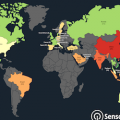PTE考生目前最大的问题之一就是练习题缺乏。除了有限的基本官方书(PLUS,Testbuilder, OG)之外,就没有题了。很多英语基础不是很扎实的同学很难找到练习材料。墨尔本文波雅思PTE培训学校专门为墨尔本,悉尼PTE考生准备了适合PTE听力阅读练习的科学60秒。各位PTE同学可以练习PTE听力中的summarise spoken text和PTE口语中的retell lecture,PTE听力口语-科学60秒-Frosty Moss练习记笔记技巧和复述。废话少说,下面开始:
Hurricanes Move Away from Equator with Expanding Tropics
听力内容:
60秒科学节目(SSS)是科学美国人网站的一套广播栏目,英文名称:Scientific American – 60 Second Science,节目内容以科学报道为主,节目仅一分钟的时间,主要对当今的科学技术新发展作以简明、通俗的介绍,对于科学的发展如何影响人们的生活环境、健康状况及科学技术,提供了大量简明易懂的阐释。
They’re technically called tropical cyclones. But these powerful storms are better known as hurricanes in the U.S. and typhoons in Asia. The violent weather systems wreak havoc on coastlines and islands in tropical areas, as the name implies.
But it looks like tropical cyclones may be moving into areas not currently considered tropical, when the storms reach maximum strength. That’s according to a study in the journal Nature. [James P. Kossin, Kerry A. Emanuel and Gabriel A. Vecchi, The poleward migration of the location of tropical cyclone maximum intensity]
Researchers looked at the global record of tropical cyclones since the 1970s. That’s when such storms started to be reliably monitored by satellites. Using those data, the researchers pinpointed the place on the globe where each storm reached its maximum intensity.
The record reveals that peak cyclone location has been shifting toward both poles at a rate of about 35 miles per decade, roughly one-half a degree of latitude.
Of course, tropical zones themselves are expanding. And the researchers suggest the cyclone shift may be linked to that growth, which is connected to more heat-trapping greenhouse gases in the atmosphere as a result of human activity. All of which means that new regions will be at risk for stronger storms as tropical cyclones spread to higher latitudes.
–David Biello





